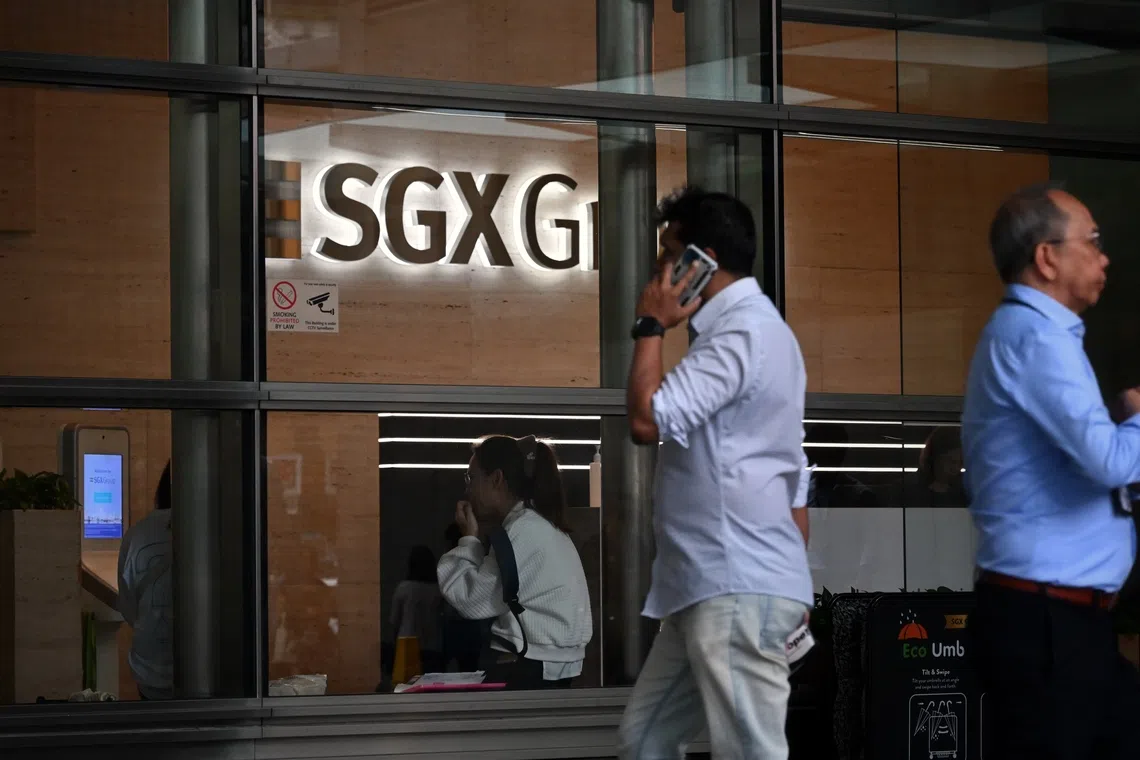Market Insights
Singapore market responds positively to new SGX-MAS measures
Sign up now: Get ST's newsletters delivered to your inbox

MAS on Nov 19 announced measures to boost Singapore's stock market, including an SGX-Nasdaq dual-listing bridge.
ST PHOTO: KUA CHEE SIONG
Follow topic:
- MAS launched measures to boost Singapore's stock market, including an SGX-Nasdaq dual-listing bridge and $2.85 billion for fund managers to invest locally.
- The measures aim to attract quality-growth companies and enhance investor engagement, with experts noting potential regulatory complexities.
- Market indices showed mixed results, with the STI experiencing a softer close despite initial gains, alongside reactions to Nvidia's results.
AI generated
SINGAPORE – The Singapore market rose after new measures, including a dual-listing bridge between the Singapore Exchange (SGX) and Nasdaq and fresh funds to be invested in local stocks to revive the stock market, were announced by the Monetary Authority of Singapore (MAS) last week.
SGX’s share price rose from $16.80 on Nov 19 to above $17 on Nov 21 before closing at $16.72 on that day.
The Straits Times Index (STI) also rose from 4,505.2 on Nov 19 to above 4,516 on Nov 20. However, it capped the week ending Nov 21 at a softer close of 4,469.1.
The iEdge Singapore Next 50 Index, which tracks the 50 largest stocks in terms of market capitalisation after excluding those on the STI, also rose, closing the week at 1,455.49.
Announced at a post-market press conference on Nov 19, the measures capped a year of work by the MAS-appointed review group. Formed in August 2024, it consulted the industry and introduced a range of initiatives to boost liquidity and bring more investors and listings to the market.
The new measures included a dual-listing bridge
It aims to attract quality-growth companies in Asia with a market capitalisation of $2 billion and above that have global ambitions and strong links to Asia.
MAS also said it will allocate $2.85 billion to a second tranche of six asset managers under the $5 billion Equity Market Development Programme announced earlier in the year.
This initiative aims to get fund managers with a range of investment styles to invest in the local stock market.
The six new fund managers announced on Nov 19 are Amova Asset Management, AR Capital, BlackRock, Eastspring Investments, Lion Global Investors and Manulife Investment Management.
Besides boosting liquidity, MAS and SGX also launched a “value unlock” programme to help listed companies strengthen investor engagement and sharpen their focus on shareholder value creation.
This will allocate $30 million to support two grants that aim to help companies improve their corporate strategy and investor relations.
A scheme that helps to support listings and expand the equity research ecosystem will also be enhanced.
Known as the Grant for Equity Market Singapore, or Gems scheme, it will receive additional funding of $1,000 for each research report generated from participating research houses.
MAS said this can help to increase the coverage of Singapore-listed companies and make the published research more accessible to younger and digitally native investors.
SGX also reduced the board lot size from 100 units to 10 units for securities above $10, to make blue chip stocks more accessible to retail investors.
Other measures included moving towards a more disclosure-based system and consolidating some functions under SGX RegCo to make it easier for companies that want to list.
Positive response from the market
Experts reacted positively to the news, saying the measures will improve firms’ access to capital and widen their investor base.
Maybank’s head of research Thilan Wickramasinghe noted that the partnership comes at a time when South-east Asia is seeing many more unicorns emerge, referring to start-ups valued at over US$1 billion (S$1.3 billion).
There were five unicorns in the region in 2016, but this number has ballooned to over 60 in 2025.
However, analysts also noted the regulatory complexities of having the dual-listing bridge, such as ensuring Singapore investors are protected when investing in US stocks and aligning both exchanges’ regulations.
The local stock market has nevertheless improved
The STI has also climbed to historic highs in 2025, although it is unclear whether this is because of more favourable market conditions or the reforms undertaken.
Over the year, the STI has risen from around 3,739 in November 2024 to above 4,500 in November 2025.
Listing activity also finally picked up after a few tepid years, with initial public offerings (IPOs) raising over $2 billion since the start of 2025.
A Deloitte report out on Nov 18
It recorded nine deals raising US$1.6 billion in the first 10½ months of 2025 – its highest proceeds since 2019’s US$2.26 billion.
Singapore also raised the highest proceeds from its IPOs among South-east Asian countries, according to the report.
This marks a rebound compared with previous years. In 2024, the SGX saw only four listings, which raised US$34 million.
In 2023, SGX saw six listings that raised US$35 million in proceeds.
New listing activity
A medical imaging and surgery technology company, UltraGreen.ai, is aiming to raise about US$400 million in an IPO
The company develops fluorescence-guided surgery technology and supplies indocyanine green dyes.
It is also building an artificial intelligence-powered surgical intelligence platform, according to its website.
It plans to list on the SGX mainboard on Dec 3 and will report in US dollars. At the offer price, UltraGreen.ai would debut with a market capitalisation of about US$1.6 billion on 1.103 billion shares on issue.
Its cornerstone investors include abrdn Asia, AIA Investment Management, Eastspring Investments, HSBC Global Asset Management and Lion Global Investors.
Meanwhile, Yangzijiang Maritime, the spin-off listing of Yangzijiang Financial Holding, debuted on the SGX mainboard on Nov 18
The stock closed at 67 cents on Nov 21, down 3.6 per cent from its previous close of 69 cents.
Yangzijiang Financial Holding closed down 3 per cent, at 49 cents on Nov 21.

Yangzijiang Financial Holding closed down 3 per cent, at 49 cents on Nov 21.
PHOTO: THE BUSINESS TIMES
Yangzijiang Shipbuilding, CDL announce business updates
Yangzijiang Shipbuilding announced its third-quarter business update on Nov 17. It bagged orders worth US$2.2 billion in the year to date, a drop from the US$11.6 billion in the same period in 2024.
The orders largely comprise small to mid-sized vessels, scheduled for delivery between 2027 and 2029. Shares of the company closed down 1.2 per cent, at $3.35 on Nov 21.
On the other hand, shares of City Developments Limited (CDL) rose on Nov 20 after it announced its divestment of its US multi-family asset
It announced that it had completed the divestment of the asset in Sunnyvale, California, for US$143.5 million to a US-based institutional investor.
Shares rose as much as 1.9 per cent after the news. CDL’s shares closed at $7.08 on Nov 21.

CDL on Nov 20 announced that it had completed the divestment of its multi-family asset in Sunnyvale, California, for US$143.5 million (S$186.8 million) to a US-based institutional investor.
PHOTO: CDL
Other market movers
Further afield, US-listed Nvidia was closely watched by investors in the US as well as in Singapore as it reported its third-quarter results.
The chipmaker said revenue jumped 62 per cent to US$57 billion, driven by demand for its chips used in AI data centres. Sales from that division rose 66 per cent to more than US$51 billion.
Nvidia reported net profit of US$31.9 billion, exceeding expectations.
The BBC also reported that fourth-quarter sales forecasts in the range of US$65 billion also topped estimates, sending shares in Nvidia about 4 per cent higher in after-hours trading on Nov 19. Shares rose above US$197 on Nov 19, from around US$180 on Nov 18.
However, by Nov 21, stocks fell again, as concerns swirled around tech companies’ continued spending on AI.
Shares in Nvidia, which had initially surged, fell by more than 3 per cent. It eventually closed around US$178 on Nov 21.
On Nov 20, the S&P 500 also ended the day 1.5 per cent lower, the Dow Jones Industrial Average fell 0.8 per cent and the Nasdaq lost more than 2 per cent, on concerns that the US Federal Reserve might hold back on cutting interest rates at its next meeting in December.
Markets rebounded slightly by the end of the week, with the S&P 500 closing at 6,602.99 on Nov 21, while the Dow Jones Industrial Average closed at 46,245.41 and the Nasdaq closed around 22,273.
What to look out for this week
The US government has reopened after its longest-ever shutdown, allowing the release of key economic data to resume.
Labour figures were out on Nov 20, showing that employers added 119,000 jobs in September
Analysts said the mixed employment data leaves more questions than answers about whether the Fed will cut rates at its next meeting and into 2026.
Other figures to watch will be the US retail sales and producer price index data out on Nov 25, which will inform the Fed’s rate decisions in December and January 2026.


